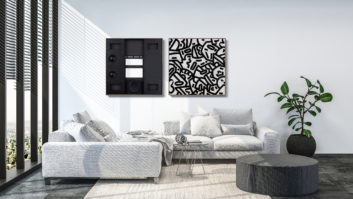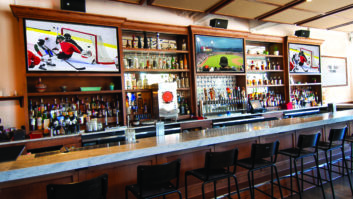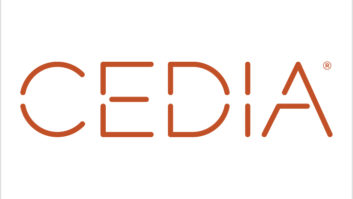Many residential systems contractors have been around long enough to have tediously tamped speaker wire under a baseboard to connect up a secondary pair of speakers in a home. And if it was a deluxe installation, it might have included a volume control and perhaps in-wall speakers as well. Aaah, the pre-historic days of multiroom audio…
Fortunately, the industry and distributed audio technology have come a long way since then. So far in fact that today an expanding myriad of technologies, products and solutions at a wide range of price points now proliferate the market. Contractors and their customers have enormous choices in a distributed audio system–some say too many choices–and it has led to confusion and a growing call for standards.
Typically distributed audio systems can be segmented into different categories. First, are “high level,” where a centralized multiroom system transmits amplified signals over speaker wire. These have rapidly given way to “low-level” systems, which too are typically centralized, but signals are transmitted at “low-” or “signal-level” then amplified locally. The latter offers several performance and convenience advantages.
Distributed audio systems are also segmented into “single-source” and “multi-source” designs. Single source indicates a system’s ability to play only one source throughout rooms or “zones” in a home while multi-source offers the ability to access multiple sources in various locations simultaneously. An increasing number of affordable single-source systems offer the added convenience of a local source input, which offers convenience while also keeping the user interface simpler.
So What’s Next?
Obviously technologies and products have continued to evolve since those early days of “multiroom,” but what technologies are around the corner and beyond and what do they mean for us? Will they converge or merely make the playing field even more varied than it currently is? And what market opportunities will they create? Several industry leaders from connectivity brands were asked where they see distributed audio headed.
Frank Sterns, vice president of sales for Niles Audio, a 24-year-old company based in Miami and one of the original connectivity brands, says that he notices two trends for distributed audio. “One is more integration of subsystems such as audio, lighting, HVAC, etc,” he said. “The other is more active electronics incorporated into multizone controllers keypads. I believe technology is influencing this by creating more smart controllers that can make complicated whole house systems easier to use for end users through one button automation.”
Sterns went on to add that he expects further technology influences due to the proliferation of digital technologies and home networking–essentially, an information superhighway through the house that carries audio, video, security data, internet, closed circuit video, etc.
Russound, founded in 1967 is one of the oldest brands in the business, and still one of the largest suppliers of volume controls and speakers selectors in the world. In recent years, they have introduced many new distributed audio technologies to their line. On their outlook for technology and the future, COO Oscar Ciornei says that he thinks that more and more source equipment will become digital. “In addition, there will be rapid growth in broadband capability and web content and control through structured wiring and home networking,” he said. “This will create a fantastic highway for A/V streaming, MPEG files, etc. Russound is designing very exciting products with that capability in mind.”
Richard Stoerger VP of Audio Design Associates (ADA) in White Plains, New York has been with the company since 1988. ADA, too, was a pioneer in multiroom audio and began in the mid-1970’s as part of a high-end custom installation business. Stoerger predicts that a variety of technologies will exist to serve different customers needs and price points.
“The final frontier in distributed audio will be a complete departure from today’s systems,” he said. “It is our belief that on the ultra high-end, consumers will desire multi-channel music playback over two-channel stereo. We’ve been saying for years that ‘stereo is dead, it just doesn’t know it yet!’ Rooms with a video display will turn into an ultimate 7.1 Dolby Digital home theater. Those without video, could support a 5.1 or 7.1 speaker array. For the discerning homeowner, one who engulfs themselves in the latest technologies, house-wide multi-channel music will be a must have.”
One of the leading loudspeaker brands and a company that has been in the custom installation industry since the beginning is SpeakerCraft. In recent years, they have augmented their speaker products with multiroom audio electronics to offer a more complete system. Vice president Jeremy Burkhardt, has a clear vision on future technology and what it will bring.
“Simplicity will dominate, keypads as they are known today will go away and digital interfaces which work with PC systems will become the norm,” he said. “The idea of a ‘dumb’ keypad or control on the wall, which is centric only to the A/V system, is lame. Digital coupled with a pc is the future.” Land Mines or Speed Bumps?
With such exciting technology and resulting products just around the corner, what obstacles could undermine the success for distributed audio? Or more likely, what challenges will exist to slow or inhibit its progress? A lack of coordination, communication and standards are generally seen as being the biggest inhibitors to growth.
Burkhardt, for one, feels that there is a total lack of communication among manufacturers. “There is no reason that every manufacturer should have a different operating system,” he noted. “We need to team up and develop a standard, instead of trying to dominate our market niche with what we think is best. Acquisitions and technology sharing are key to growing this technology to the masses.”
Ciornei agrees that a lack of standards may be the biggest challenge facing the industry. “Designers of distributed audio hardware need to address standards in copy protection, wire requirements, efficiency of speakers and amplifiers to name a few,” he said. “Another significant challenge is education and training, particularly in the home building industry. The builders must be educated on the benefits of our products to their customers and why it will give them a competitive advantage. They also need to be challenged to include wiring in their projects. In addition, dealers and integrators need to understand how to deal with homebuilders and how to motivate them.”
Sterns echoed a similar sentiment stating that, “system complexity can be a liability. Manufacturers, system designers and installers need to stay focused on delivering real benefits to customers rather than technology exercises for technology’s sake.” Sterns added that, on a non-technical leve,l the short-term challenge is getting out of the current recession and predicts that will happen in late 2002.
Opportunities Ahead
Despite the many challenges, and a seeming lack of solutions to them, all are quite optimistic about the opportunities in our industry and particularly in distributed audio.
Stoerger foresees massive growth in the custom installation market in the next five to 10 years, with distributed audio being a key factor in integrated home systems. “Because distributed audio is an entertainment system, it will be an easy choice for both installers and consumers to accept,” he said. “The resistance of both presentingthis technology to the consumer and the consumer’s acceptance of the technology is lower, compared to other system integration options.”
Burkhardt, continuing to sound a digital theme, predicts that “Digital music through digital speakers will enhance sound quality while making the installations wireless and easy.” He feels that the market is poised for substantial growth and should easily grow 20 percent per year for the next five years.
Sterns sees continuing opportunities in new custom homes and emerging opportunities in spec homes. “Simple whole house in a box systems for retailers should represent a good growth segment. And as Gen x’ers begin to reach their maximum earning years, I expect to see increased digital home control systems proliferate as these customers are more comfortable with computers.”
Ciornei also believes that structured wire and Cat-5 will dominate the distribution of audio and video in homes. “In fact, the low cost of Cat-5 and structured wire systems will open up the market to lower income families and offer them Jetson’s type solutions. Consumers are slowly, but surely, becoming aware that they can have and afford such convenience and luxury.”
Stoerger summed up the business opportunity with sage advice. “The success or failure for the existing custom installer will be the manner in which they operate their business,” he said. “If they are good business people, they will not only survive any new competition, they should actually thrive. There will always be those consumers who will want better service and product mix than the mass merchants can provide. As the number of consumers interested in our toys increases, so will the net number of upscale consumers-the kind we deal with today which is the kind we want.”
Peter Hoagland is an industry marketing consultant in Warrenton, Virginia.







